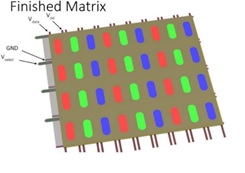June 2020:
Hi- Accµracy: We are pleased to announce that a pan European consortium including PVI has received EU Horizon 2020 funding. The three year Hi- Accµracy project will develop next generation display technologies utilising printed electronics down to µm size, for Organic Large Area Electronics (OLAE) Thin Film Transistor (TFT) and Display Applications.
HI-ACCURACY aims to deliver the next generation of large area manufacture of flexible OLAE structures such as organic Thin Film Transistors (OTFTs) and Electroluminescent Quantum Dot Light Emitting Diode (EL-QD-LED) displays, to µm-scale feature size printable onto flexible substrates. This is aimed at the large and exciting printed, flexible and organic electronics global market, estimated to be worth € 28.3bn with an annual growth rate of >8% which is mainly dominated by displays. Hi-Accuracy will display front- and back-plane structures with feature sizes approaching 1 µm using low cost materials that can operate at frequencies of >1MHz. 
This will be achieved through a unique range of cutting-edge materials and printing inks, in combination with inherently scalable, cost-effective printing and deposition approaches, that have non vacuum or minimal vacuum requirement. Specifically, the electronic materials will include a range of low-temperature curable nano-Ag and nano-Au conductors and p-type organic semiconductors with intrinsic mobility of 10-20sq.cm/V.s as well as InP, ZnSe and ZnS Quantum Dot (QD) materials and electroluminescent EL-QD-LED material stacks with multilayer barrier layers that can achieve the required WVTR and oxygen transmission rates.
HI-ACCURACY is an ambitious project with a pan-European EU consortium of world leading research centres and cutting-edge SMEs that are looking to develop and commercialise these technologies.
The project is endorsed by three major global electronics companies: Huawei, Sony and Polar (global manufacturers of displays and wearable health monitors) who will sit on the External Expert Advisory Board and steer the project towards commercialisation. The final project demonstrators will be validated by SME partners and the resulting displays will be further processed and validated by the end-user partners in their test facilities (TRL5).